July at the cottage
Article from the rubric "Calendar of gardener's, gardener's works, florist"

Your garden: work of the month.
By the beginning of July, the growth of annual shoots ends in fruit trees. At this time, watering should be reduced so as not to cause a second wave of growth. In dry hot weather, water will have to be watered once every 2 weeks, but in moderate doses. And then plow the soil, zamulchirovat. If you notice still growing shoots in the crown, pinch them.
July work on the strawberry plantation
On a strawberry plantation after harvesting, remove the whiskers if they are not needed to breed or fill rows. All excess mustache must be removed from the plantation no later than the beginning of August. At the same time, weed out all the weeds.
Apply full mineral fertilizer to the cleaned soil: 10-15 g of urea, 40-60 g of superphosphate, 15-20 g of potassium sulfate per 1 running meter of row spacing.
Useful closer to the bushes sprinkle humus or compost. Loosen the soil between rows at 10 cm depth. Spud the bushes lightly, scooping the ground towards the horns for better root formation.
If the strawberry has suffered from pests (mites, weevils), you can spray it with fufanon-nova. Against diseases, you can add 30 g of homa (or abigak-pik) or 100 g of colloidal sulfur.
To kill ticks and prevent diseases, it is effective to mow the affected leaves and whiskers immediately after fruiting. It is impossible to be late with pruning: the bushes should recover and prepare for winter.
Immediately after mowing and removing the leaves, the plantation should be sprayed with one of the insecticides (fufanon, actellic, colloidal sulfur or thiovite jet), adding abig-peak or hom, zircon or agate 25-K. After that, apply complex fertilizers, water and crush between the rows.
If you leave the leaves, remove the whiskers, except those you need for seedlings. The remaining activities are the same as those recommended after mowing the leaves.
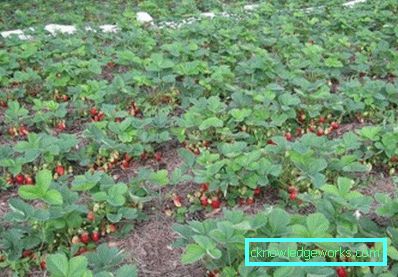
Repair grades twice in July pollinate with freshly sour lime or ash from slugs (20 g per square meter).
Currant
On currants after the end of the harvest, powdery mildew, anthracnose, and septoriosis can occur. Against American powdery mildew, topaz (2 g) or colloidal sulfur (30 g per 10 l of water) or tiovit jet (20-30 g) can be used. Tiovit jet can be used on the gooseberry, despite the fact that it is also a sulfur preparation.
Raspberries
On the raspberry after harvesting, cut off the sprouts to the ground. Spray fufanon from pests, from diseases - abigak-pik or khom.
Cherry
After harvesting, cherries should be protected from moniliosis (cut off dried branches, sprinkle chorus on the crown), coccomycosis (leaves turn yellow and fall off) and other fungal diseases (hom), from cherry mucous sawfly (kinmiks).
Cherries
In July, form the crown of young cherries. Cut branches on the ring, directed inside the crowns, thickening. Shorten too long annual increments (more than 50 cm). Slices process garden pitch. For fruit trees, cut out the center conductor at a height of 2-2.5 m.
Pear
If pear seedlings do not grow well, check to see if the root neck is not buried during planting, or if you re-moisten the soil.
Plum
In plum, the main pest in July is the plum moth, which began to harm it in June (the first generation), and in the first decade of July, the first-generation caterpillars leave for pupation under the lagging bark, into cracks of shtambs, into the soil, weaving cocoons there and pupating. After 8-10 days (mid July) second-generation butterflies come out, laying eggs on the fruits of late varieties. After 4-8 days, caterpillars, damaging the fruit, hatch.
Apple tree
On summer varieties of apples, pears, fruit picking is coming. Do not use chemicals on them. Spray aphids with garlic or succinic acid (1 g per 10 liters of water).
Winter varieties for better storage of fruits spray extrasol (10 ml per 10 liters of water).
Do not forget about pests
Every day, collect the drops, spray trees fufanonom (mid-July).
Against monilioz, klasteros-poriosis, add to the insecticide solution home or abigak-peak.
The second generation of the codling moth also hurts in July. A damaged drop should not be left under the trees. Clean daily, along with fresh carrion, you remove from the garden a significant part of the caterpillar caterpillars.

Catcher belt on tree trunks.
Once every 10 days, look at the trapping belts on the apple tree shtamb.
In the summer, it is better to use biopreparations to control the crop moth:
- lepidocide (20-30 g)
- fitoderm (15 g)
- Bitoxibacillin (40-80 g)
They have a waiting period of 2 to 5 days. After 8-10 days spraying repeat.
From scab, powdery mildew on an apple tree and a pear in a working solution, add a speed or tiovit jet.
Copper-containing drugs can form a grid on the fruit.
Feed trees and shrubs
In the second decade of July, most garden crops begin planting fruit buds. Take care of the future harvest and feed the trees and shrubs with phosphorus-potassium fertilizers: 20 g of superphosphate and 15 g of potassium sulfate per 1 sq. Km. m pristvolny circle. Add fertilizing with irrigation. In hot, dry weather, water the garden 2 times a month.
If the tree branches are actively growing, make a second summer nip: remove the tops of competitors or break them out just like the top shoots. If they are needed to replenish or correct the shape of the crown, these shoots can be pulled and tied up.
Blackberries have grown young shoots. In June, you pinned their tops by 4-5 cm. As a result, lateral shoots began to grow actively. Control their growth. Pinch the tops of the shoots, leaving 40 cm.
In July berries of a currant, a gooseberry, a raspberry ripen. Collect black currants in a timely manner: over-ripe berries crack, fall off. For red and white currants, they can stay on the bushes for up to a month if there is no rain.
If you are processing gooseberry berries, remove them slightly unripe. When fresh, they are tasty when they are soft and painted in the color characteristic of the variety.
After harvesting all the berries pour and feed the full mineral fertilizer
In July, work on the budding
Budding in the butt - how it is doneIn late July, you can begin to graft apricots, peaches, but with plums, cherries, pears, and apple trees, this work can be done before. Prepare the rootstocks for budding: clean the shtambiki of seedlings, pour heavily. The easiest way - budding in priklad. Graft eyes take from shoots as thick as a finger at a distance of 10-15 cm from the base. Carefully remove the leaves, with a sharp knife cut out in the growth direction of the graft eye, surrounded by a small area of the bark. The length of the shield is about 3 cm, the peephole is in the middle. On the stock perform a cut of identical shape. Place the peephole with a flap in the incision on the stock. They tie a vaccination site with a film tape, leaving only the kidney open.
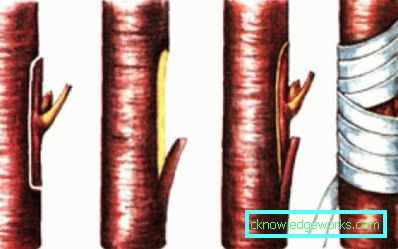 That is the budding in the butt. |
Seasonal work in the garden. July.
The season has just started, and now it's midsummer. By the daily work on the vegetable beds are added billet chores.
It would seem that there is simply no time to look at every bush in the garden. But it was not there. Someone will see that the leaves on the pepper for some reason turned inside out. Someone will be alarmed that the leaves on the cucumbers in some places like gnawed.
And the leaves on the pepper, perhaps, just turned the wind. There are varieties that have leaves on longer than other varieties, petioles. That's them and pats. We will not be able to help the plants in such a situation. In cucumbers, the leaves could damage both locusts and caterpillars of the meadow moth.
I would like to advise meticulous gardeners not so meticulously to look closely to their beds. Not the attention itself is alarming, but the fact that after each “oh, what happened!” Cardinal measures follow: spraying the plants with everything that is in the garden first aid kit.
It seems that summer residents do this more for their own comfort, not taking into account that any spraying with chemical pesticides weakens the immunity of plants.
Without making a diagnosis, do not touch the sprayer!
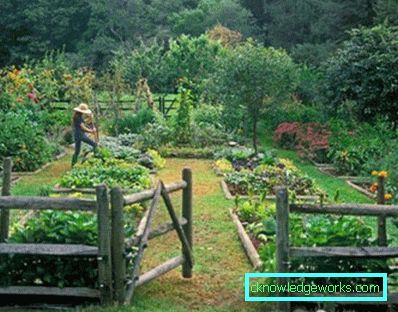
Now, especially when we have been harvesting cucumbers, zucchini, crumbled Peking cabbage and white cabbage from our garden, for a month (and some more), we use protective equipment with great care: only allowed for personal subsidiary farming and only for a short period waiting
What could harm our beds in July?
The likelihood of manifestation of viral diseases is still strong. After the temperature drops, rains may appear dark stripes on the stalks of tomatoes. This is strick. Infection occurred earlier, and the weather only helped to manifest the disease.
But the symptoms of diseases vary depending on the viruses that have “settled” in the plants: these can be mosaic-yellow leaves on potato or tomato bushes, corrugated leaves on pepper, mosaic leaves, and shortened internodes on cucumbers.
Single painful plants are better to remove, and the rest every 7-10 days to spray milky-iodine solution (liter of skim milk or skim milk + 11 drops of iodine to 9 liters of water).
Foliar fertilizing with microelements, spraying with a fitolavin will also play its protective role. But let's not take pity in the hope that the disease will recede: there are no drugs against viruses.
We can only facilitate its course, do not let the plants perish. If the disease manifests itself massively, it does not make sense to remove the affected plants: continue to care for them in order to get at least some crop.
Influence of weather on the development of diseases
What diseases, pests of vegetable crops will add to the list in July, depends on the weather. Hot, dry weather will “propagate” ticks and thrips, and therefore regular spraying of cucumbers, zucchini and eggplants with phytoverm will remain in force.
Rains, high humidity can cause the development of peronosporoza, late blight. Alternaria can manifest itself on plants weakened by the virus.
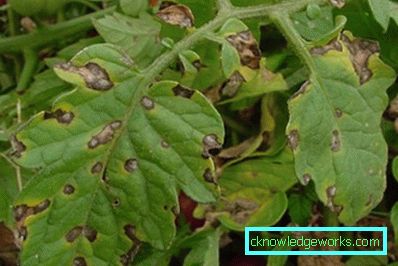
Late blight on tomatoes.
With these diseases, treatment with chemical fungicides can no longer be postponed.
When late blight initially on the tops and on the periphery of the lower leaves appear watery spots, which soon necrotic and die. Under favorable conditions, the disease quickly covers all the leaves, growing fruits.
Temperatures above 26 degrees, dry air inhibit the development of the disease. It is necessary to remember this in order not to process tomatoes with copper-containing preparations in the middle of summer, when the heat is over thirty degrees.
The temperature within 18-20 degrees, the presence of dew drops, rain or irrigation water on the leaves for 8-9 hours - favorable conditions for the onset of the development of peronosporoza, or downy mildew on cucumbers.
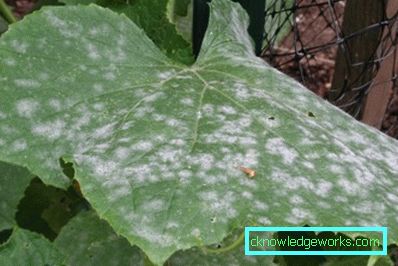
Downy mildew (peronosporoz) on cucumbers.
Watery spots bounded by leaf veins quickly turn yellow, then necrotic and crack. Diseased leaves spin along the central vein down and dry out. In favorable conditions, cucumbers can die in a few days.
Alternaria blotch can develop on tomatoes in greenhouses at high humidity. Growing dark brown spots may appear on the leaves, stems, fruits.
As prevention of late blight and Alternaria on tomatoes, cucumbers, as well as with the weak development of these diseases, spraying with the biological fungicide phytosporin-M is used.
If plants need urgent help, spraying with abigac-peak (50 g per 10 l of water) will be more effective, but this fungicide is not used on plants at harvest time, since it has 20 days to wait for it.
Mealy dew on carrots
In July, the development of powdery mildew on carrots is quite possible. A gray-white patina appears on the petioles and leaves of diseased plants. If you do not take action, the leaves will turn brown, wither, root crops, not receiving food, will cease to develop, become wiry.
The disease develops in humid, warm conditions. Therefore, it is very important to thin the carrot so that it is better ventilated, burst or grind the aisle.
Early carrots with formed roots at the first signs of illness are better to dig, root vegetables gently wash, dry and put in the refrigerator. Late varieties of carrots and June sowing carrots should be processed soon, because before cleaning is still far away.

Mealy dew on carrots.
You can read: "What to do if powdery mildew appeared on the carrot"
Leaf parsley, celery leaf, sorrel, if any spots appear on them, completely cut, feed with complex fertilizer or organic infusion, water, i.e., stimulate the rapid regrowth of young leaves.
Summer menu for garden beds
Paying great attention to the fight against pests and diseases of vegetable crops, do not forget that the main thing now is different. We need to strive to ensure that the plants were comfortable even in the most adverse weather.
Plants become vulnerable to disease after suffering stress:
Make sure that the land in the garden does not dry out. Loosen the soil, mulch with organic matter to create more favorable conditions for plant roots.
Will help to actively grow, to produce fruits and vegetables regular foliar feeding with complex fertilizers with microelements, humates, bichal. Such “feeds” are especially needed during stressful periods, when the roots of plants do not absorb nutrients from the soil.
Tomatoes, peppers during the period of fruit formation, it is advisable to regularly feed calcium nitrate on the leaves to reduce crop losses from the top rot of the fruit (a tablespoon of calcium nitrate on a bucket of water).
Calcium in the soil can be enough, but in hot weather it is practically not absorbed by plants, and cannot move from leaves to fruits, like some other nutrients.
It will help the fruits of tomatoes to ripen foliar phosphorus top dressing faster. From 1-2 tablespoons of superphosphate do the hood: pour a liter of hot water, insist day, stirring, remove from the sediment and add water to the bucket.
If you want to harvest crops from a cucumber bed for a long time, feed them every ten days to keep the lash growing. There will be no growth, there will be no new ovaries.
For 10 liters of water, take a teaspoonful of urea, potassium sulfate, add 0.5 liters of mullein infusion or green grass. You can do it easier - dissolve a tablespoon of complex water-soluble fertilizer in a bucket of water.
And as often as possible, harvest, do not let the cucumbers outgrow. Even one giant cucumber is able to slow down the development of other fruits on the plant.
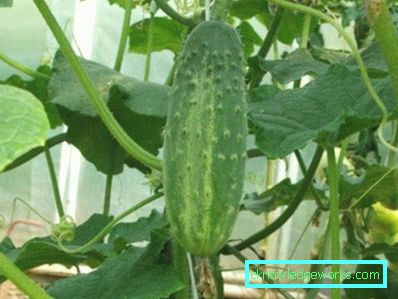
You can read: "5 proven methods of feeding cucumbers"
The same dressing is also suitable for zucchini, pumpkin, but the share of organic infusion for them can be increased to a liter.
On other vegetable crops, discard nitrogen supplements in order not to provoke the development of diseases, the accumulation of nitrates. Carrots, beets feed with potassium sulfate (a tablespoon in a bucket of water).
We water according to the weather
Particular attention to watering. It is important to conduct it with the weather, and not irrigation schedule. On hot days, when intense evaporation occurs, it may be necessary to water more than twice a week, during the hot hours to conduct illuminating irrigations to reduce the temperature and increase the humidity of the air around the plants.
On cooler days you need to temper your “irrigation heat”. The excess water, displacing the air from the soil, disrupts the physiological processes of the plants, they look depressed, although, as it seems to us, they just have enough: water, food, and our care.
One thing is removed, the other is sown
In July, we are preparing for the digging of garlic, early varieties of onions, planted with a sevka, family onions, two weeks before this, having stopped watering. This must be done so that the bulbs ripen well. A well-ripened onion is easily pulled out of the ground.
Garlic harvesting
We scoop up the garlic when the leaves turn yellow, the arrows straighten up and the shirts break on them. For the sample, you can dig up a few heads. It is better to dig with a fork, so as not to accidentally damage the heads.

Keep the garlic in the ground until the heads begin to decay into teeth, it is impossible. Such garlic will not be stored. Better to hurry a little with digging, than to be late.
Garlic, without pruning the tops, dried in a well-ventilated room, spread out in a single layer or tied in a spit and hanging.
Properly remove the bow
If the bow did not seem to have heads out of the ground, break it a little. This is necessary in order for the bulbs to ripen better, to become thinner neck. Such a bow will be better kept.
Cut the tops not immediately after digging, but after drying. From the recommended drying in the open sun discard. Upper succulent scales in direct sunlight will get burned.
You probably had to clean the bulbs with brownish succulent scales, which can later rot. These are the negative effects of improperly dried onions - in the open sun.
Cabbage can give additional yield
We will harvest other vegetables in July: early varieties of white cabbage, cauliflower, broccoli, early carrots. Carefully cut the crop of white cabbage and broccoli, pour, feed with organic infusion and we will wait for the second harvest.

At cut white cabbage we will later remove small coaches that have emerged from the sinuses, leaving 1-2 of the largest, so that they give us an additional harvest.
Broccoli is released "at will", but we make sure that the inflorescences that form from the lateral buds do not outgrow or bloom (we regularly cut them off).
Cut off the heads of cauliflower, immediately pull out the stumps, chop and lay in the compost. From cauliflower wait for the second harvest does not make sense.
The vacated plot can be planted with green manure. It is better if it is not mustard, which is of the same family with cabbage and is affected by some pests (for example, a cross-colored flea).
For summer planting on siderata fit fatselia, oats. It is also possible to get a second crop of vegetables by sowing bush asparagus beans of early ripening after cabbage. She will give the harvest and improve the soil.
We dig up the carrots, wash them, dry them, put them in plastic bags and put them in the refrigerator. It does not make sense to keep weighty roots in the garden: they do not have enough taste, they will only get overloaded.
The beds are filled with compost or good humus and we sow there early varieties of cabbage (cauliflower, broccoli). After sowing, we soil the soil surface with grass, after the emergence of shoots, we “powder” wood ash to scare away cruciferous pests.
If re-sowing is not necessary, let the land rest under the sideratami. But in any case, do not leave the bed to overgrow with weeds or, even worse, to roast in the sun.
The bed from which the peas or beans have been removed can be left under planting strawberries. Legumes are considered good precursors of this berry crop.
At the end of July you can sow daikon, kohlrabi cabbage for the autumn table and winter harvesting. You can select a site for them after legumes, potatoes, early carrots, onions, and garlic. Think in advance about the land for planting garlic.
Good predecessors of this culture are:
- peas
- cabbage
- potatoes
- roots
So that the bed chosen for garlic is not empty until October, it can be planted with sideratami in order to dig them up in September.
If you still do not know how to improve the land on the plot with the help of siderats, then you will probably be interested to read the article "Siderats. Planted, and then what?"
And in the middle of summer you can re-plant potatoes
We dig up potatoes of the April planting and sow the site with green manure or, having improved the soil with compost and humus, we sow cucumbers to preserve in late summer-autumn, when the heat subsides.
If there is a place and seed tubers, plant potatoes. The surface of the beds after planting is desirable to be mulched with grass in order to create wetter and cooler (as far as possible during the July heat) conditions for the germination of tubers.
This bed before germination can be watered with sprinkling, without fear of the formation of a crust. By mulching we protect potatoes after germination.
No waste, there is organic
Carrot, pea, bean tops, cabbage leaves (it would be good to chop them a little with a shovel) are put into compost, sprinkled with soil and watered so that it all rot faster, turns into a good organic fertilizer.
It is possible to use special biological preparations for quick preparation of the compost.
What you need to take care of flower growers in July
Your flower garden: work month.
Faded plants, so that they remain beautiful until the end of the season, and the following year pleased with even more abundant flowering, they require our attention.

We prune the flowering peduncles and flowers, feed the plants with phosphorus-potassium or complex fertilizers (under the root and over the leaves). During stressful periods (change of weather, intense heat) we will help plants to preserve immunity: we spray them with solutions of humates, trace elements, HB-101.
We make sure that traces of pests and diseases do not appear on the leaves and stalks. Be sure to cut (if you have not done this before) faded carpet plants (obriyetta, carnations, etc.).
They will give fresh shoots, and neat thick curtains will delight until late autumn. Do not leave withered inflorescences and more powerful perennials. Cutting the peduncles at the delphiniums, be sure to wait for re-flowering.
Carefully, on one level, cutting the stems of faded lilies, create a green background for other plants. Removing the fodder baskets of cicatricia, calendula, tying seeds of inflorescences of snapdragon, we not only restore the beauty of flower gardens, but also extend the flowering period of plants.
If you do this regularly, it will not take as much time as it may seem.
Do not forget to sow new flowers
In some flowers that breed by self-sowing:
- eastern poppy
- aquilegia
- feverfew
- escholzia
- Nigel
- calendula and others
you can leave a few seed pods - let them spread, seedlings can always be removed or transplanted into a flower garden.
But the seeds of biennials:
- medium bell
- pansies
- Turkish carnation
- daisy
will have to collect themselves. You can sow them right away to wait for flowering next season.
True, it is difficult to get the shoots in hot weather. But if you choose a plot for a hotbed in a half-shaded place, cover it with non-woven material on the arcs, you can count on success.

Sowing biennials in the second half of the summer saves us a whole season. Just do not forget about the seedlings: water on time, feed them, thicken the seedlings and thin them out so that the “youth” grows strong and strong.
It is already difficult to care for the soil among the overgrown perennials: you can damage the roots and break off the stems with a hoe. Therefore, shaking the ground shallowly, where it is still possible, we mulch open areas.
For taking care of your favorite plants, find time to admire them. From your admiring glances they will become even more beautiful.
And also collect paints and smells of summer for the winter. The most suitable day is July 7th.
It was on the night of Ivan Kupala that our grandmothers collected herbs for amulets. Bouquets lit in the church and hung in the house. It is believed that on this day medicinal plants are especially healing.
Well, why don't we prepare lemon balm, oregano, thyme for winter? And just in case, go to your fern at night: suddenly it blooms!
A fairy tale is a fairy tale, but for every summer resident there is a grain of truth in it: you don’t need to go far to find the treasure pointed by flowering fern, you have already created this treasure with your own hands in your garden, growing beautiful plants.
Other articles from this rubric: